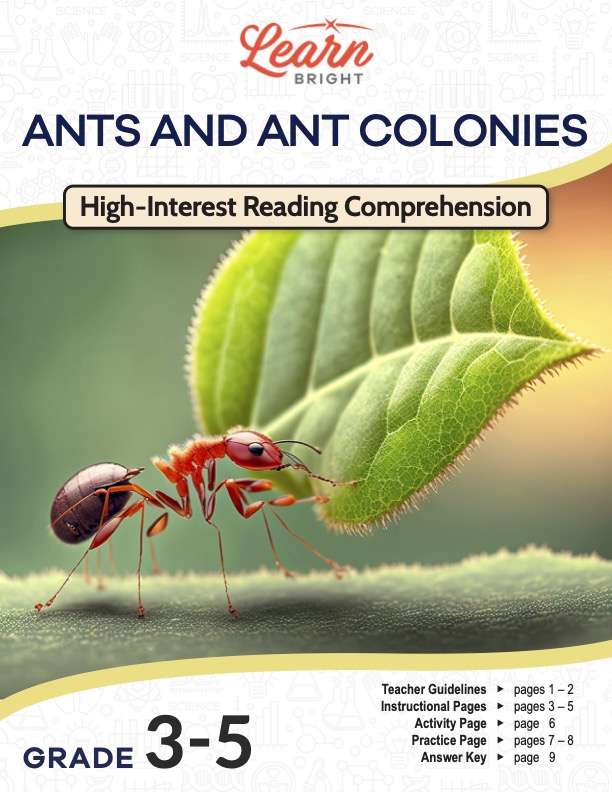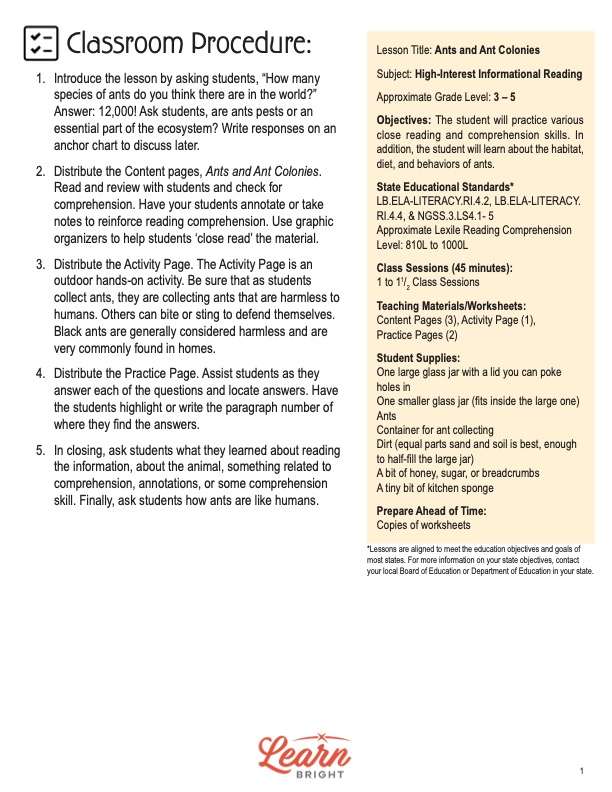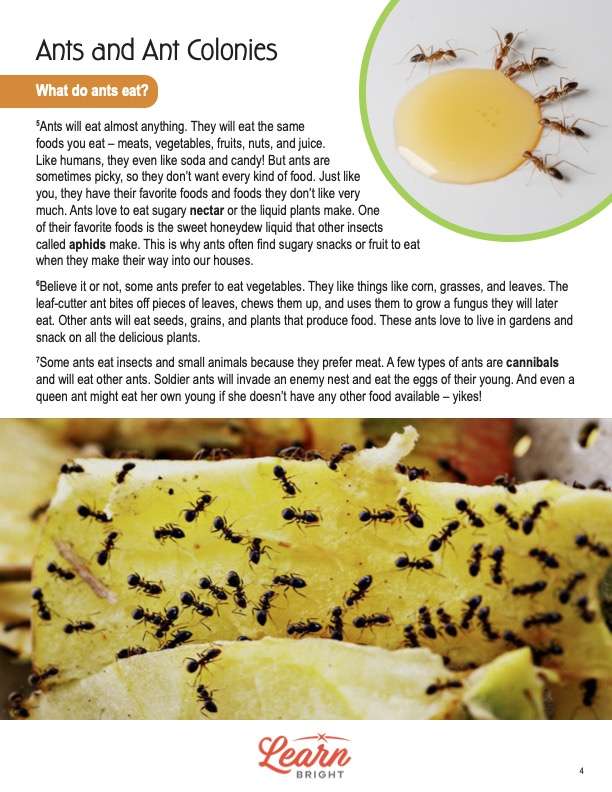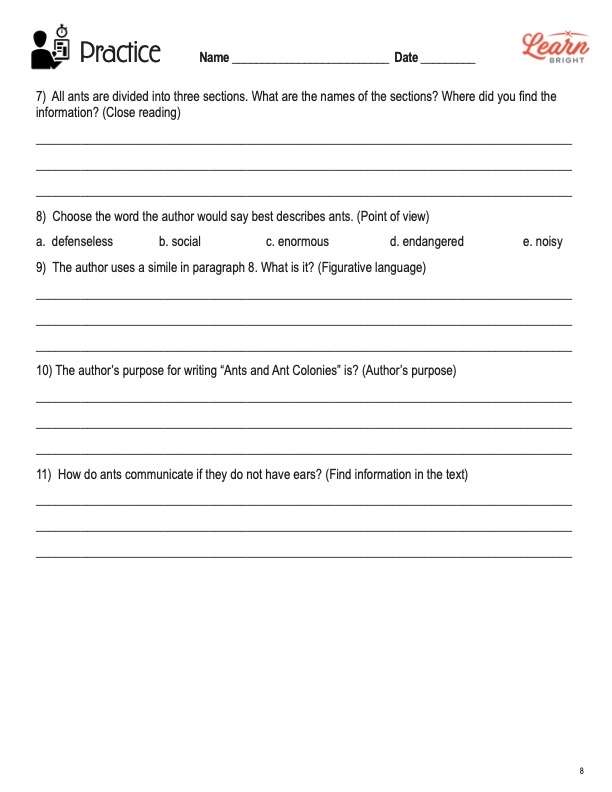Description
What our Ants and Ant Colonies lesson plan includes
Lesson Objectives and Overview: Ants and Ant Colonies is a high-interest reading comprehension lesson plan. As such, students will practice various close reading and comprehension skills. In addition, they will learn about the ant’s habitat, diet, and behaviors. This lesson is for students in 3rd grade, 4th grade, and 5th grade.
Classroom Procedure
Every lesson plan provides you with a classroom procedure page that outlines a step-by-step guide to follow. You do not have to follow the guide exactly. The guide helps you organize the lesson and details when to hand out worksheets. It also lists information in the yellow box that you might find useful. You will find the lesson objectives, state standards, and number of class sessions the lesson should take to complete in this area. In addition, it describes the supplies you will need as well as what and how you need to prepare beforehand. For this lesson, you will need a variety of materials for the activity, including a large glass jar with a lid you can poke holes in, one smaller glass jar that fits inside the large one, an ant container, dirt, sugar, and a piece of kitchen sponge.
Teacher Notes
The teacher notes page provides an extra paragraph of information to help guide the lesson and remind you what to focus on. It explains that you can teach this lesson in a whole-class setting or to an independent, small group as an activity. The blank lines on this page are available for you to write out thoughts and ideas you have as you prepare the lesson.
ANTS AND ANT COLONIES LESSON PLAN CONTENT PAGES
What Are Ants?
The Ants and Ant Colonies lesson plan contains three pages of content. It first provides the overview box with a few pieces of information. Ants are a type of insect that lives everywhere in the world but in Antarctica, Iceland, Greenland, and some islands. Their diet consists of milk of aphids, plant and fruit sap, and live or dead insects. They can live anywhere from a few weeks to 15 years depending on the species.
There are several types of ants that live all over the planet. They range in size from 0.08 to 1 inch long and come in various colors like yellow, red, brown, or black. Regardless of the different sizes and colors, all ants’ bodies divide into three sections: the head, thorax, and abdomen.
An ant’s mouth is one of its most essential parts. In addition to eating, ants use their mouth for fighting and carrying food or other materials. The mouth consists of two jaws: an outer pair and an inner pair. In addition, ants have two antennae on the top of their head, which they use for guidance, smell, and communication.
Like humans, ants are very social. They live in large colonies or groups, some of which contain over a million ants. A colony has three kinds of ants: the queen, female workers, and males. The workers do not have wings, but the queen and the males do. The queen is the most important ant in the colony because only she can lay eggs. Male ants are part of the colony to help the queen lay eggs. Once they do their job, they don’t live for very long afterward.
Sometimes, there is more than one queen in a colony. Once the queen becomes an adult, she will spend the rest of her life laying eggs. Because she is vital to the colony’s survival, special soldier ants protect her. These soldier ants will also defend the colony, gather or kill food, and attack other enemy colonies for food or a new place to live.
What They Eat
Ants will eat almost anything. In fact, they will eat many of the same foods we eat—meats, vegetables, fruits, nuts, and juice. Like us, they even like soda and candy! But ants are sometimes picky, so they don’t want every kind of food. They have their favorite foods and foods they don’t like very much just as we do. Ants love to eat sugary nectar or the liquid plants make. One of their favorite foods is the sweet honeydew liquid that other insects called aphids make. This is why ants often find sugary snacks or fruit to eat when they make their way into our houses.
Believe it or not, some ants actually prefer to eat vegetables. They like things like corn, grasses, and leaves. The leaf-cutter ant bites off pieces of leaves, chews them up, and uses them to grow a fungus they will later eat. Other ants will eat seeds, grains, and plants that produce food. These ants love to live in gardens and snack on all the delicious plants.
Some ants eat insects and small animals because they prefer meat. A few types of ants are cannibals and will eat other ants. Soldier ants will invade an enemy nest and eat the eggs of their young. And even a queen ant might eat her own young if she doesn’t have any other food available!
Other Interesting Facts
You may be familiar with the idiom, “as industrious as an ant.” People say this to refer to someone who works really hard. This is because ants work very hard and rarely take breaks. When an ant is working, it often lifts items that are 20 times its body weight. If humans were as strong as an ant, we could pick up a car!
Having brothers and sisters can be difficult, but imagine having millions of brothers and sisters. Some queen ants can live for many years; throughout their lives, they will have millions of baby ants. But when a queen dies, the colony can only survive for a few more months since the workers cannot have babies.
Another cool fact: ants don’t have ears. Instead, they feel the ground’s vibrations through their feet to “hear.” But how do ants know where to find food if they can’t hear other ants tell them where it is? When ants go foraging for food, they leave pheromone trails for other ants to follow as a map of where they have been. Additionally, ants don’t have lungs. Instead of breathing in oxygen and breathing out carbon dioxide, they have tiny holes all over their bodies where oxygen enters and carbon dioxide leaves.
Ants play an essential role in the environment. Their colonies help turn and aerate (or introduce air into) the soil, allowing water and oxygen to reach plant roots better. Seed-harvesting ants take seeds into their tunnels and eat part of them. Then the other part can grow into a new plant. Ants also eat pests that are harmful to crops and orchards. For instance, garden ants will eliminate pests like caterpillars. Plus, ants provide food for birds and lizards.
ANTS AND ANT COLONIES LESSON PLAN WORKSHEETS
The Ants and Ant Colonies lesson plan includes two worksheets: an activity worksheet and a practice worksheet. Each one will help students solidify their grasp of the material they learned throughout the lesson. You can refer to the classroom procedure guidelines to know when to hand out each worksheet.
ANT FARM ACTIVITY WORKSHEET
For this activity, students will get to create their own ant farm and watch nature at work. They will first poke a few holes in the lid of a large jar that will allow their ants to breathe. The holes must be very tiny, though, so that the ants can’t escape. Students will then place a smaller jar upside down in the large one to form an inner wall of sorts. This will keep ants near the sides of the larger jar where people can see them.
Next, students will fill the space between the two jars with dirt, leaving an inch or two of space at the top. Then they must go out and find some ants. Using their containers, they should collect as many ants as possible and gently transfer them to the jar. They can then place some honey, sugar, or breadcrumbs on the top of the jar, along with a wet sponge, before screwing on the lid tightly.
Occasionally, students should also add more food, and they should keep the sponge damp so that the dirt doesn’t dry out. If the dirt does get too dry, they can add a small amount of water, just a tiny bit at a time to avoid drowning their ants.
ANTS AND ANT COLONIES PRACTICE WORKSHEET
The practice worksheet requires students to answer a series of 11 questions. These questions all relate to the content pages, so students will need to refer to them often for the answers. In addition, each question provides which reading tool the question corresponds to, such as text feature, vocabulary, or comprehension.
Worksheet Answer Keys
At the end of the lesson plan document is an answer key for the practice worksheet. The correct answers are all in red to make it easier for you to compare them with students’ responses. If you choose to administer the lesson pages to your students via PDF, you will need to save a new file that omits these pages. Otherwise, you can simply print out the applicable pages and keep these as reference for yourself when grading assignments.









